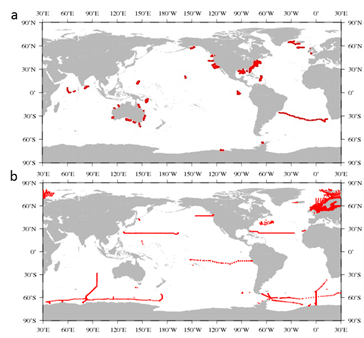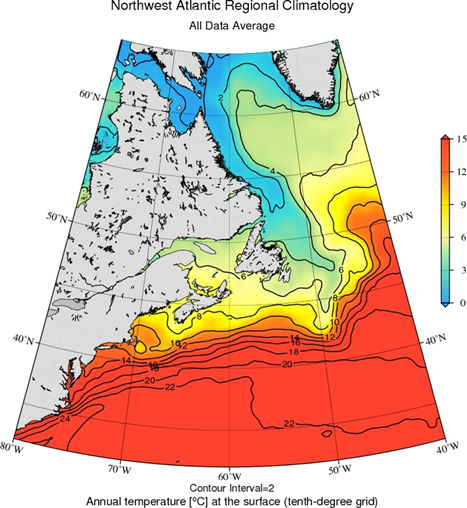World Ocean Database Updates and Seasonal Estimates of Ocean Temperature, Salinity, Heat Content, and Steric Sea Level
Research Topic:
Climate Data & Information Records/Scientific Data Stewardship
Task Leader:
Alexey Mishonov
CICS Scientist:
James Reagan
Sponsor:
NESDIS NCEI
Published Date:
9/26/2017
2017 ANNUAL REPORT
Dr. Alexey Mishonov (NOAA Collaborators: Dr. Krisa Arzayus, Dr. Rost Parsons, Tim Boyer)
James Reagan (NOAA Collaborators: Dr. Krisa Arzayus, Dr. Rost Parsons, Tim Boyer)
Background
NOAA's NationalCenters for Environmental Information (formerly National Oceanographic Data Center) (NCEI) is an organization (http://www.ncei.noaa.gov/) that provides scientific and public stewardship for national and international marine, environmental, and ecosystem data and information. With its regional branch assets and divisions(http://www.nodc.noaa.gov/General/NODC-About/orgchart.html), NCEI is integrated to provide access to the world's most comprehensive sources of marine environmental data and information. NCEI maintains and updates a national ocean archive with environmental data acquired from domestic and foreign activities and produces products and research from these data which help monitor global environmental changes.
The World Ocean Database (WOD) is one of the most requested products from the NCEI (http://www.nodc.noaa.gov/OC5/WOD/pr_wod.html). It is a vast hydrographic database that includes over 15.1 million profiles dating back to Captain Cook’s second voyage in 1772. In order for the WOD to keep growing, and to keep being used by the public for a multitude of different ocean and climate studies, data from the NCEI archive must be continually processed and merged into the WOD. This requires that the data be converted into a common format, checked for uniqueness and quality, and merged into the WOD. CICS staff is heavily involved in WOD’s continual maintenance and expansion.
The WOD is also used to calculate gridded climatologies of the ocean. The World Ocean Atlas as well as a multitude of regional climatologies (http://www.nodc.noaa.gov/OC5/indprod.html) have been created from the WOD. The climatologies require extensive amounts of quality control (QC) to ensure an accurate product. The World Ocean Atlas offers global climatologies of temperature, salinity, dissolved oxygen, apparent oxygen utilization, oxygen saturation, silicate, phosphate, and nitrate. The WOD is further used to calculate pentadal (5-year), annual, seasonal, and monthly temperature and salinity anomalies, which for some compositing periods (e.g., pentadal) date back to 1955. These anomaly products are used to calculate ocean heat content for multiple depth layers, and sea level changes arising from temperature (thermosteric) and salinity (halosteric) changes. The anomalies and associated products can be found at: https://www.nodc.noaa.gov/OC5/3M_HEAT_CONTENT/. The regional climatologies are created based on the public’s need and additionally constrained by the regional hydrographic data distribution. Because regional climatologies are only calculated in regions of high data distribution, vertical resolutions of 102 standard levels and horizontal resolutions up to 1/10th degree are attainable. CICS staff is involved in the creation and QC of these products.
Accomplishments
-
World Ocean Database
The WOD was updated four times (quarterly) over the past year. Constant data updates to WOD are needed to maintain and enhance the database. CICS staff’s responsibility is to populate WOD on a quarterly basis with bottle and CTD data from the CLIVAR & Carbon Hydrographic Data Office (CCHDO) and the International Council for the Exploration of the Sea (ICES). Temperature and salinity data collected by various gliders all around the world and submitted by the Integrated Ocean Observing System (IOOS), Integrated Marine Observing System (IMOS), the University of Washington, and other providers were also added to WOD on a quarterly basis. We also processed the annual update of CTD data from the Northeast Fisheries Science Center (NEFSC) and other miscellaneous datasets for inclusion in WOD. Figure 1a-b shows all data CICS staff added/updated (~233,000) in WOD over the past year.

Figure 1. Geographical distribution of a) glider and b) bottle and CTD (Conductivity-Temperature-Depth) profiles added to WOD by CICS staff during 2016/17. There were a total of ~222,000 glider profiles and ~11,000 bottle and CTD profiles.
-
Ocean Heat and Salt Content
CICS staff assisted in the creation and QC of the 2016 globally gridded seasonal temperature and salinity anomaly products, which were released four times (quarterly) over the past year. Additionally, during January 2017 CICS staff quality controlled the 2012-2016 (pentad) and the 2016 annual temperature and salinity anomalies along with the 2016 monthly salinity anomalies. The January 2017 updates are especially important and time sensitive due to these products being extensively used in both the “Salinity” section, in which CICS staff co-authors, and the “Ocean Heat Content” section of the “State of the Climate in 2016” report in the Bulletin of the American Meteorological Society (BAMS).
The pentadal salinity anomalies were extensively used in a manuscript currently under revision lead by CICS staff. The manuscript investigates global salinity pattern amplifications (i.e., salty regions becoming saltier and fresh regions fresher) over varying time periods from 10-60 years. Salinity pattern amplifications have been shown to be directly related to amplifications in the global hydrological cycle, and with historically unreliable estimates of evaporation and precipitation over the ocean, global salinity patterns provide us with a way of monitoring the changes in the hydrological cycle over the past 60 years.
The World Ocean Atlas 2013 and the pentadal temperature anomalies were used extensively in a manuscript currently under review. The manuscript analyzes changes in ocean heat content (OHC) over the North Atlantic Ocean over the past six decades. CICS staff are co-authors on this work.
-
Regional Climatologies
Some CICS staff are members of the Regional Climatology Team at NCEI. The Regional Climatology Team is responsible for creating and performing QC on high-resolution climatologies of temperature and salinity in data-dense regions of the global ocean that are of particular interest to the broader scientific community. During 2016 the Regional Climatology Team completed the regional climatology of the Northwest Atlantic. The Northwest Atlantic Regional Climatology composes of six decadal climatologies from 1955-1964 through 2005-2012. The climatology horizontal resolution ranges from 1-degree to 1/10th-degree and contains 102 standard vertical levels. For each decade, annual, seasonal, and monthly fields are available. Figure 2 is an example of the 1/10th-degree sea surface temperature field of the six decade average.

Figure 2. The Northwest Atlantic Regional Climatology six decade average of the 1/10th-degree field of sea surface temperature. The six decades include 1955-1964, 1965-1974, 1975-1984, 1985-1994, 1995-2004, and 2005-2012
Planned work
-
Continue to discover, assess, acquire and archive the wide array of new ocean data as they become available.
-
Continue to process data for inclusion in WOD. This includes CCHDO, ICES, NEFSC, and glider data, as well as other data sets received by NCEI.
-
Continue to QC monthly, seasonal, annual, and pentadal temperature and salinity anomaly fields derived from the WOD.
-
Develop climatological (and anomalous) mixed layer depth (MLD) fields using multiple MLD criteria.
-
Continue to analyze salinity variability through satellite and in situ data.
-
Continue to analyze the relationship between salinity and evaporation/precipitation
-
Continue to participate in the Regional Climatology Team activities
-
QC of decadal-scale climatological fields for the Greenland, Iceland, and Norwegian Seas (GINS) including recalculation of fields after different stages of QC
-
Create updated version of maps for the different oceanographic variables
-
Analyze long-term changes in temperature and salinity in the Gulf of Maine and GINS
-
Continue to participate in OHC research
-
Begin preparing for the next release of the World Ocean Atlas (World Ocean Atlas 2017)
-
QC of World Ocean Atlas 2017 temperature and salinity fields
-
Update documentation
-
Begin preparing for the next release of the World Ocean Database (World Ocean Database 2017)
-
Creation and quality control of global ocean in situ derived sea surface density fields.
Publications
Peer-reviewed (published):
1. Reagan, J., T. Boyer, C. Schmid, and R. Locarnini, 2016: Subsurface salinity [subsection in "State of the Climate in 2015"]. Bull. Amer. Meteor. Soc., 97 (8), S72–S73.
Peer-reviewed (in review):
2. Reagan, J., T. Boyer, C. Schmid, and R. Locarnini, 2017: Subsurface salinity [subsection in "State of the Climate in 2016"]. Bull. Amer. Meteor. Soc..
3. Seidov, D., A. Mishonov, J. Reagan, A. Parsons, 2017: Multidecadal variability and climate shift in the North Atlantic Ocean. Geophysical Research Letters.
Peer-reviewed (under revision):
4. Reagan, J., D. Seidov, T. Boyer, and M. Zweng, 2017: The time-evolution of climatically significant salinity trends in the World Ocean. Geophysical Research Letters.
5. Tyler, R., T. Boyer, M. Takuto, J. Reagan, and M. Zweng, 2017: Electrical conductivity of the global ocean. Earth, Planets and Space.
Not peer-reviewed (published data atlas):
1. Seidov, D., O.K. Baranova, T. Boyer, S.L. Cross, A.V. Mishonov, and A.R. Parsons, 2016, Northwest Atlantic Regional Ocean Climatology. NOAA Atlas NESDIS 80, Tech. Ed.: A.V. Mishonov. Silver Spring, MD, 56 pp.; doi:10.7289/V5/ATLAS-NESDIS-80.
Products
1. World Ocean Database – Quarterly Updates/Releases
2. Most recent release of pentadal (2012-2016), annual (2016), seasonal (2016), and monthly (2016) temperature and salinity anomaly gridded products
3. Seidov, D., O.K. Baranova, D.R. Johnson, T.P. Boyer, A.V. Mishonov and A.R. Parsons (2016), Northwest Atlantic Regional Climatology, Regional Climatology Team, NOAA/NCEI (www.nodc.noaa.gov/OC5/regional_climate/nwa-climate), dataset doi:10.7289/V5RF5S2Q.
4. Seidov, D., O.K. Baranova, T.P. Boyer, A.V. Mishonov and A.R. Parsons (2016), Northern North Pacific Regional Climatology, Regional Climatology Team, NOAA/NCEI, (www.nodc.noaa.gov/OC5/regional_climate/nnp-climate), dataset doi:10.7289/V5KK98TQ.
5. Mishonov, A. & NCAR Staff (Eds). "The Climate Data Guide: World Ocean Atlas 2013 (WOA13)." https://climatedataguide.ucar.edu/climate-data/world-ocean-atlas-2013-woa13.
Presentations
A. NOAA/NESDIS CoRP Science Symposium (18-19 July 2016; Fort Collins, CO)
1. Reagan, J., T. Boyer, and M. Zweng. The World Ocean Database: Connecting Ocean Observing Systems since 1994.
B. CICS Science Conference (29-1 November/December 2016; College Park, MD)
1. Reagan, J., D. Seidov, T. Boyer, and M. Zweng. The time-evolution of climatically significant salinity trends in the World Ocean.
C. 2016 Fall AGU Meeting (11-16 December 2016; San Francisco, CA)
1. Reagan, J., D. Seidov, T. Boyer, and M. Zweng. Long-term (> 40 years) monitoring of near-surface salinity needed to detect global changes in the hydrological cycle.
2. Gardner, W.D., M.J. Richardson, and A.V. Mishonov. Particle Mass in Deep-water Benthic Nepheloid Layers: A Global Synthesis.
3. Seidov, D., A.Mishonov, J.Reagan, T.Boyer, A.Parsons, and S.Cross. Ocean Climate Shift Derived from Northwest Atlantic Regional Climatology.
4. Mishonov, A.V., M.J.Richardson, W.D. Gardner, and T. Boyer. Historical and Modern Deep-Sea TransmissometryDatain World Ocean Database – its Status, Challenges, and Utilization.
Other
1. Awards
“Global Transmissometer Database” project by Wilford D. Gardner (TAMU), Alexey Mishonov (CICS-MD) and Mary Jo Richardson (TAMU) received an Honorary Mention at ‘The 2016 International Data Rescue Award in the Geosciences’ competition (https://www.elsevier.com/physical-sciences/earth-and-planetary-sciences/the-2016-international-data-rescue-award-in-the-geosciences).
2. Mentoring/Advising
J. Reagan is co-advising (with Dr. James Carton) an undergraduate’s senior research project in the Department of Atmospheric and Oceanic Science (AOSC) that is focused on salinity and AMOC variability. Student is expected to graduate in fall of 2017 after presenting a poster on her research.